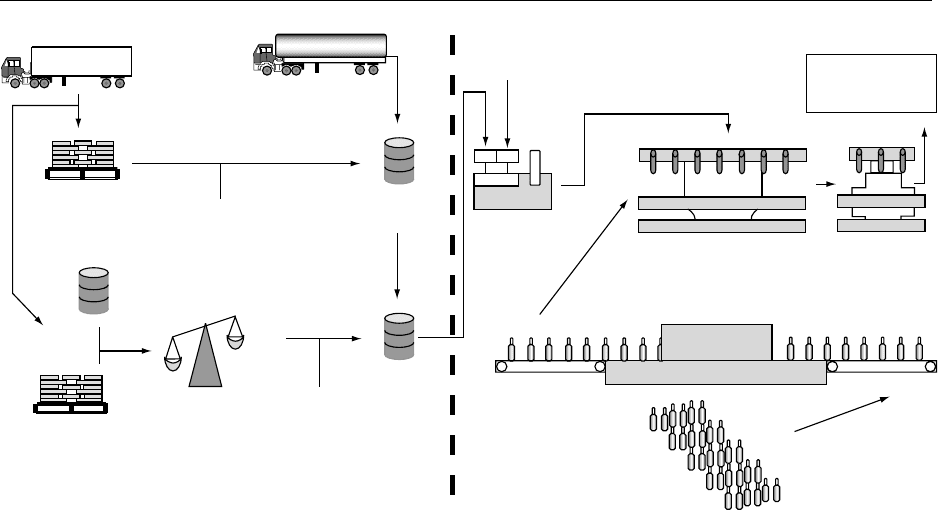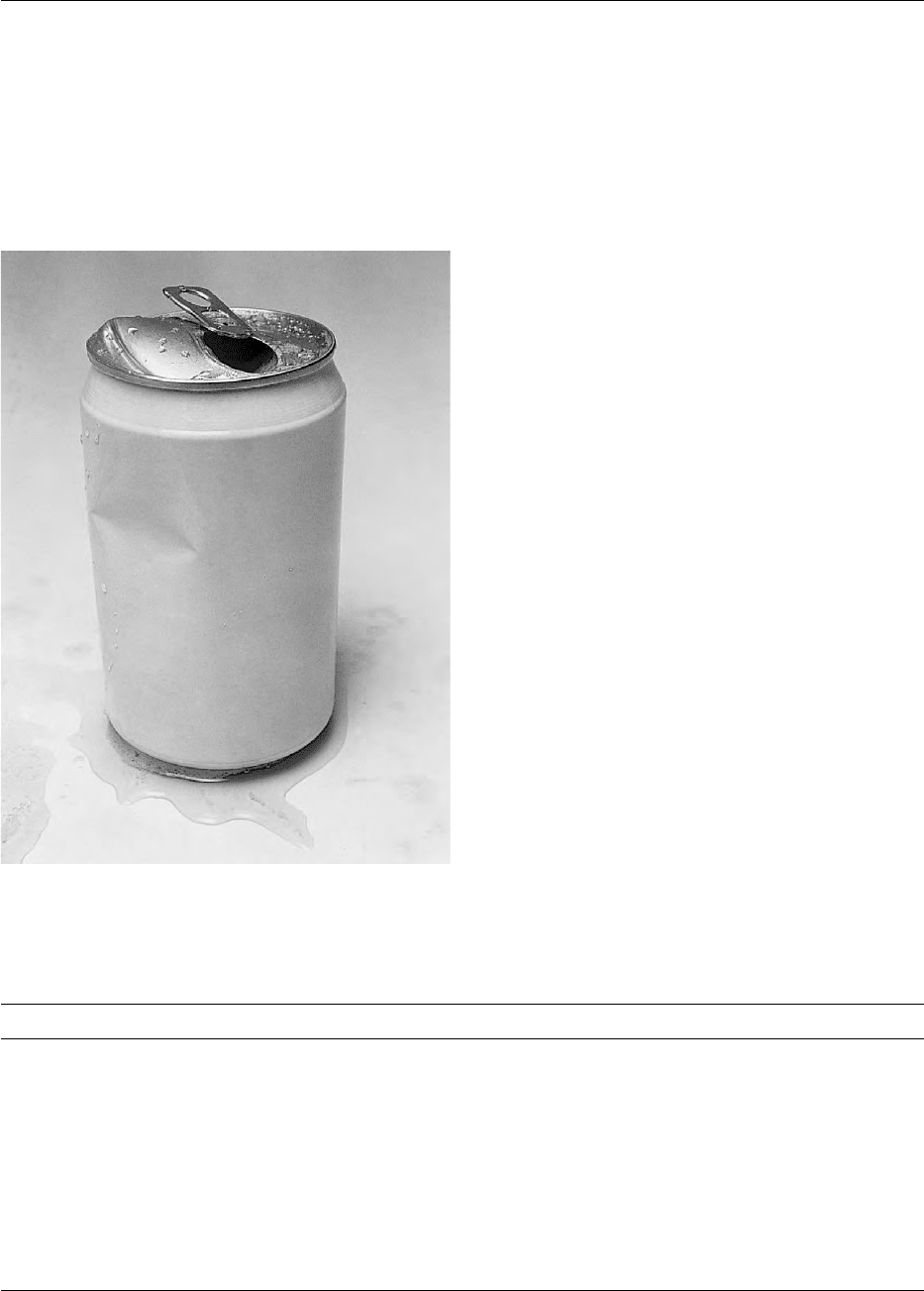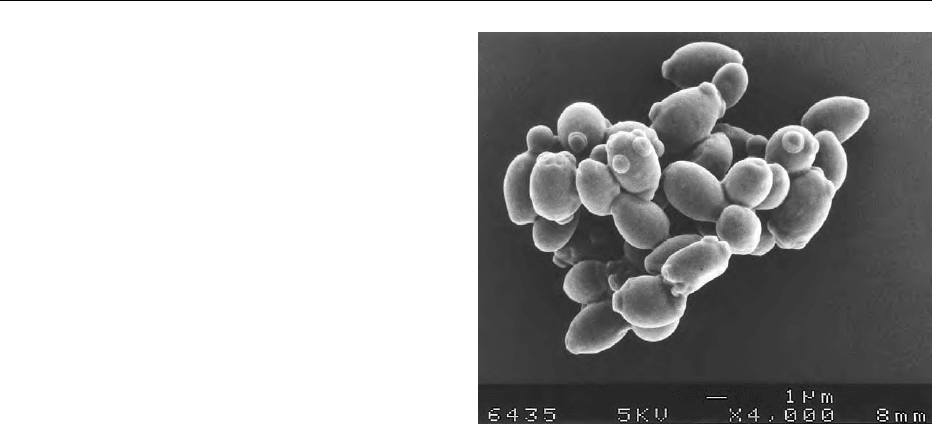Caballero B. (ed.) Encyclopaedia of Food Science, Food Technology and Nutrition. Ten-Volume Set
Подождите немного. Документ загружается.


.0058 63
C for 10 min: typically used for shandies
.
0059 70
C for 10 min: typically used for squashes
.
0060 75
C for 15 min: typically used for susceptible
products such as high-blackcurrant-juice products.
0061 Tunnel pasteurization may be considered as a
continuous version of in-pack pasteurization.
0062 After the product has been filled, packed, and
seamed, the packages are transported through a
tunnel made up of different heat zones by means of
water of different temperatures being sprayed over
the packages, which gradually increase in tempera-
ture to the selected pasteurization level where they are
then held for the desired time (holding time) before
being cooled slowly to ambient temperature. Process-
ing time is approximately 40–50 min, resulting in
very effective pasteurization at relatively high cost
(it is energy-intensive and filling has to proceed at
the speed of the pasteurizer).
0063Flash pasteurization
Nonaseptic conditions This system may be used for
carton, polyvinylchloride, polyethylenetetraphthalate
(PET), and all other nonglass/metal drinks packaging
materials, and is suitable for both still and carbonated
beverages. The heat exchanger is connected in line
with the product mixing tank in the case of still prod-
ucts and the intermediate syrup tank in the case of
carbonated products. The syrup or finished product is
heated very quickly to the specified pasteurization
temperature, held for the specified time (usually
quoted as seconds), and cooled rapidly to the filling
temperature. The final drink may also be passed
through the heat exchanger in this way en route to
the carbonator if required.
0064The advantage of this type of pasteurization is that
the total heat input to the product is only a fraction of
that required for in-pack pasteurization and results
in considerably reduced flavor, color, and shelf-life
Ingredient blending
(quality check)
Intermediate
ingredient blending
(quality check)
Concentrates
Carbonates
Ingredient blending
Ready-to-drink still
Pasteurize
(90−95 8C for
10−45 s)
Pasteurize syrup
(90−95 8C for
10−45 s)
(where necessary)
Pasteurize
(90−978 C for
10−45 s)
Homogenize
(2000−3000 psi)
Dilute and carbonate
Fill: glass and
plastic bottles*
Case/palletize
Distribute
Case/palletize
Distribute Distribute
Fill: can, glass and
plastic bottles*
Either
or
or
1. Aseptic conditions
Pasteurized liquid is
filled into part-formed
containers which are
then sealed and finished
before proceeding to
the packing line
2. Hot-fill conditions
Hot pasteurized liquid
is filled into finished
packs which are sealed,
inverted for 1 min, and
cooled
3. Unpasteurized liquid is
filled into finished pack*
Case/palletize
Note: These processes may operate via an intermediate syrup or (partly or
throughout) on a ready diluted basis
* In-pack pasteurization performed where necessary with temperatures up to 70 8C for up to 20 min.
fig0003 Figure 3 Key stages in the processing of soft drinks.
SOFT DRINKS/Production 5357

effects. The disadvantage is that contamination may
occur during filling and/or capping and rigorous stand-
ards of hygiene and microbiological control must be
adhered to by fully trained and committed staff. It may
even be necessary to fill some products/packs in
enclosed areas with overpressure sterile air rooms.
0065 Aseptic conditions Before a discussion on the types
and methods of aseptic flash pasteurization, it is
necessary to consider exactly what this means in real
terms.
0066 Asepticity is sometimes referred to as commercial
sterility, but it is necessary to recognize the important
microbiological differences between the two types of
processing employed.
0067 With sterility it is realistic to expect that all meas-
urable organisms have been killed by the process,
which is almost always carried out at temperature
conditions well in excess of 100
C in hermetically
sealed containers, thus insuring the microbiological
integrity of the whole pack (product plus packaging).
0068 In aseptic packing the product is heat-treated separ-
ately from the container and maintained in positive air
pressure conditions (thus excluding any potentially
contaminating organisms) until filled and sealed into
the selected pack, which has been separately treated to
reduce any microbiological contamination on its sur-
face. Examples of aseptic conditions are those which
apply to the Tetra Pak process where the product is
flash-pasteurized at 96
C for 13 s and filled into card-
board previously treated with hydrogen peroxide; this
is formed into a tube and the individual pack seams
are carried out through the product.
0069 With aseptic processing/packaging it is generally
recognized that, independently of any pack integrity
problems, the normal failure rate will be of the order
of one pack in every 10 000 produced. A better rate
than this is rarely achieved and aseptic conditions are
sometimes quoted with failure rates as high as one in
3000, as in the case of carbonated products packed in
PET containers.
See also: Pasteurization: Principles; Preservation of
Food; Quality Assurance and Quality Control; Storage
Stability: Parameters Affecting Storage Stability; Water
Supplies: Water Treatment
Further Reading
Cullen KW, Ash DM, Warneke C and de Moor C (2002)
Intake of soft drinks, fruit-flavored beverages, and fruits
and vegetables by children in grades 4 through 6. Ameri-
can Journal of Public Health 92(9): 1475–1478.
Fried EJ and Nestle M (2002) The growing political move-
ment against soft drinks in schools. Journal of the
American Medical Association 288(17): 2181.
Heath HB (1981) Source Book of Flavours. Westport: AVI.
Hicks D (1990) Non-Carbonated Fruit Juices and Fruit
Beverages. Glasgow: Blackie.
Matthews AC (1991) Food Flavourings. Glasgow: Blackie.
O’Donnell K (1990) Formulation and Production of
Carbonated Soft Drinks. Glasgow: Blackie.
Microbiology
M Stratford and C J Capell, Unilever Research,
Sharnbrook, UK
Copyright 2003, Elsevier Science Ltd. All Rights Reserved.
Background
0001‘Soft drinks’ is a term often used to describe all bever-
ages with the exception of alcoholic or hot beverages.
This includes a vast array of products ranging in
composition from mineral waters, sports drinks, diet
formulations, colas, mixers, and tonics to fruit juices.
Some soft drinks are sparkling (carbonated), whereas
others are still. Some are manufactured with a desig-
nated shelf-life greater than a year, whereas others are
sold for immediate consumption (freshly squeezed
juices). As a consequence of this variation in com-
position and packaging, the microbiology of soft
drinks also shows considerable variation. Some
soft drinks form an environment so hostile, or so
deficient in nutrients, that the microflora is nearly
nonexistent, and spoilage is consequently rare.
Other soft drinks, such as fruit juices of a higher pH
(Table 1) form an environment ideally suited to rapid
proliferation of yeasts, molds, and bacteria. For the
purposes of this article, the average soft drink will
be considered to have a pH between 2.5 and 3.5
(Table 1), sugar at 5–10%, 1–3gl
1
citric acid (or
titratable acidity equivalent), and fruit juices
or vegetable extracts sufficient to comprise a source
of minerals and vitamins for microbial growth.
0002In theory, the presence of microbes in a food prod-
uct can have any one of three possible effects. It can
be a positive attribute, growth of specific microbes
creating desirable organoleptic changes, as in
tbl0001Table 1 pH range and acids prevalent in various soft drinks
and fruit juices
Beverage pHrange Acids
Apple juice 2.9–4.5 Malic, citric
Orange juice 2.6–4.3 Citric, malic
Blackcurrant juice 3.0–3.8 Citric
Grapefruit juice 2.9–3.6 Citric
Lemonade 2.8–3.2 Citric
Cola 2.5–2.8 Phosphoric
5358 SOFT DRINKS/Microbiology

fermented foods or alcoholic beverages. It can be a
negative attribute, causing illness in the consumer or
spoilage of the food, or it can be entirely neutral, the
presence of microbes having no effect whatsoever on
the food or on the consumer. In soft drinks, microbes
are almost never beneficial, a possible exception being
the oriental acidic tea, Kombucha, fermented by
yeasts, molds and acetic acid bacteria. In the great
majority of instances, the presence of microbes in soft
drinks is entirely neutral. Most bacteria are sensitive
to the acidity of soft drinks, whereas the majority of
yeasts and molds may be suppressed by a lack of
oxygen within the soft drinks packaging (Table 2).
Any such organisms tend to arrive in bottles of soft
drinks in low numbers and have no impact whatso-
ever on the beverage. Most will die in this environ-
ment within a few hours to a few weeks, depending
on the organism.
0003 A small minority of microbes, however, find the
soft drink environment suitable for proliferation and
growth to substantial populations. These are the soft-
drinks spoilage flora (Table 2). Although the occa-
sional microbe per liter of beverage has little impact,
growth to 10
5
cells per milliliter results in visible
spoilage, and 10
6
–10
8
cells per milliliter are sufficient
to cause very considerable changes to the chemistry
of the beverage. Such changes are almost always
organoleptically unacceptable and in themselves
constitute spoilage.
Manufacturing Process of Soft Drinks
Process
0004 Fruit-juice manufacture typically occurs close to the
area of production. Fruit is processed to remove
leaves, stems, etc., washed, milled, and crushed. The
juice is usually extracted from the crushed pulp by
pressure. Single-strength juice is bulky and is often
concentrated at the site of production. Juices are
heated to near 100
C, a vacuum is applied, and
water is removed by evaporation. Volatile compon-
ents are recovered and added back after cooling. To
ensure microbiological stability, concentrates may
then be frozen, preserved, or aseptically filled into
drums.
0005Soft-drinks manufacture (Figure 1) essentially in-
volves dissolving weighed amounts of flavors, juices,
acids, antioxidants, and sugars into water. This is
then dispensed into the appropriate packaging.
Sugar enters the syrup room of the factory either as
granules, which are dissolved in hot water, typically
85
C/30 s or as 67
Brix syrup, known as ‘simple
sugar syrup.’ Other components of the soft drink,
acids, flavors, fruit juices, vegetable extracts, antioxi-
dants, etc., are weighed out and dissolved in water.
These are added to the simple sugar syrup, forming
the final syrup at 40–50
Brix. The final syrup is piped
from the syrup room to the proportioning pump in
the filling hall (Figure 1). Here, it is proportioned
with water to form the product, typically, 7–10
Brix.
This is filled into bottles/cans/tetrapaks at the filler,
which are then sealed at the capper.
Sources of Infection
0006Microbes may enter soft drinks and their production
facilities from a number of sources. These may dir-
ectly infect products or may colonize various sites
within the factory and subsequently cause infection
from these sites. Entry to the factory is most common
on raw materials, returned bottles, via insects or aerial
vectors.
0007Aerial contamination obviously depends on the
microbial loading and composition in the air. Nearby
sources of microbes greatly increase the microbial
load, e.g., breweries, dust sources (harvesting or
building work), fruit storage, or processing of fruit
or vegetables. Fresh fruit are routinely heavily sur-
face-contaminated with yeasts and molds, 10
3
–10
6
per gram. Factories processing fruits will inevitably
become contaminated with the molds associated with
those fruits’ spoilage flora. Ascomycetous molds pro-
duce conidiospores for dispersal and ascospores for
survival. Conidiospores are often airborne; asco-
spores often are not, making the presence of the
heat-sensitive conidiospores generally more common
as airborne contaminants. Aerial contamination is
highly seasonal, with mold spores predominating,
tbl0002 Table 2 Summary of the growth, spoilage, and safety significance of microbes in soft drinks
Microbe Growth Inhibition Spoilage Safety
Spoilage yeasts þ Excess gas Exploding bottles
Other yeasts Low O
2
Spoilage molds þ Mycelium Possible mycotoxins
Other molds Low O
2
Vegetative bacterial pathogens, e.g. Salmonella spp.,
E. coli VTEC (enteropathogenic E. c oli )
Low pH Food poisoning, in fresh,
unpasteurized, fruit juices
Acid-tolerant bacteria + Low O
2
Taints, slime
Most bacteria Low pH
SOFT DRINKS/Microbiology 5359

and is probably the most significant cause of mold
spoilage. (See Microbiology: Classification of Micro-
organisms.)
0008 Insects are becoming increasingly recognized as a
vector for yeasts. Many insects carry yeasts and acid-
tolerant bacteria between flowers, actively consume
yeasts as part of their diet, and benefit from yeast
colonization of their digestive systems. Insect frass,
notably from fruit flies (Drosophila spp.), is particu-
larly rich in soft-drink spoilage yeasts.
0009 Returned bottles, when brought into the factory,
form a potent source of microbial infection of soft
drinks. Returned bottles are frequently cap-less and
unwashed, often containing a residue of soft drink.
Storage at ambient temperature allows selective
growth of spoilage microbes in the residue up to
high levels and formation of stationary-phase sur-
vival mechanisms, such as heat-resistant ascospores
by yeasts and molds. Stringent bottle-washing re-
moves almost all residues, but fungal debris and
viable ascospores can persist through the whole
process. Fruit-flies, attracted to the sugary residues
in returned bottles, can also spread infection around
the factory.
0010 The microbial loading of raw materials is normally
low where materials have been selected from good
quality sources. Sugar granules, 67
Brix syrups, or
fruit-juice concentrates are a potential source of
contamination. Fruit juices are often heavily contam-
inated; citrus fruits are especially associated with mold
spoilage, as the fruit defense is most susceptible to
pectinolytic molds. Pasteurization of the single-
strength juice or the concentration process should
result in a near-sterile product, except for rare heat-
resistant molds. Byssochlamys spp. and Talaromyces
spp. have been the cause of spoilage in pasteurized
fruit juices. The ascospores of these molds are rela-
tively uncommon, but significant growth of the mold
on the raw material must have occurred for the pres-
ence of problematic numbers of ascospores. Similarly,
mold spores in small numbers may survive the sugar
refining process. Both fruit juice concentrates and
sugar syrups are more likely to acquire an osmophilic
flora through mishandling after cooling. Owing to the
low water activity, only osmophilic yeasts and, more
rarely, molds can grow, albeit very slowly in sugar
syrups. Other ingredients, such as water, flavors, acid-
ulants, colorings, antioxidants, and preservatives, are
also possible sources of spoilage microorganisms.
0011Build-up or colonization of a spoilage flora within
the factory is probably the most significant source of
infection. It has been estimated that 95% of yeast
infections of soft drinks are caused by poor plant
hygiene. Soft-drink manufacture is generally a very
high-volume throughput operation, with up to
36 000 l h
1
passing through each filling line. Little
time is therefore allowed for growth of microbes
within the bulk volume of liquid, before pasteuriza-
tion or addition of preservatives. Microbial build-up
is therefore most significant in dead spaces or on
Delivery
Granulated
sugar
Fruit juice
Water
Water
Chemicals
flavours, acids,
antioxidants,
preservatives
Ingredient
preparation
Water
Final
syrup
Syrup room
Filling hall
Returned
bottles
Bottle washer
Filler Capper
Proportioner
Simple syrup
storage
Conveying
Secondary
packaging and
warehousing
fig0001 Figure 1 Schematic diagram of a soft-drinks production facility. In the syrup room, sugars are dissolved in water to form simple
syrup, and juices and flavors are added to form the final syrup. This is pumped into the filling hall, diluted with water by the
proportioning pump, and filled into bottles. Bottles are then capped, packaged, and distributed. Tunnel pasteurization is applied to
capped bottles or ‘in-line’ pasteurization between the proportioner and filler.
5360 SOFT DRINKS/Microbiology

surfaces proximate to the product stream. Areas most
at risk include the proportioning pump, filler and filler
heads, and capper. Other areas of concern include old,
dried splashes of fruit juice or soft drink, the syrup
room, particularly where ingredients have been spilled
or allowed to become damp, and drains into which
sugars are washed. (See Contamination of Food.)
Microbial Stability
0012 Microbial stability can be achieved by preventing
viable microbes entering the product, (aseptic filling),
sterilization (pasteurization), or by factors preventing
microbial growth in soft drinks (preservation). Pas-
teurization is the most effective method of eliminating
microbes in soft drinks (Table 3). Vegetative yeast and
mold cells are generally heat-sensitive, almost all being
killed in 10 min at 60
C. Pasteurization of fruit juices,
such as orange juice, which are typically heavily con-
taminated with yeasts and molds, range from 10 to
15 min at 70–75
C. Such pasteurization will not elim-
inate heat-resistant formsof molds, such as ascospores.
0013 The microbial stability of soft drinks can be
achieved most simply and effectively by ‘in-pack’ ster-
ilization, downstream from the capper using a tunnel
pasteurizer (Table 3). This insures absence of microbes
in the bottle and cap as well as the product. Alterna-
tively, products may be sterilized ‘in-line’ using a plate
pasteurizer and aseptically filled into sterile bottles, or
products may be given a flash in-line pasteurization to
lower the microbial loading and preservatives added
to prevent the growth of surviving microbes. Fresh-
pressed fruit juices that would normally spoil within 2
days may be preserved by chilled storage for a limited
period of time, e.g. 2–3 weeks.
0014 Some factors suppressing microbial growth are
intrinsic to the composition of soft drinks, such as
the phosphoric acid in cola or the low pH that inhibits
or kills the majority of bacteria. Pressurized CO
2
in
carbonated soft drinks has a pronounced antimicro-
bial effect, particularly against molds and bacteria.
Fermentative yeasts are more resistant, particularly
Brettanomyces spp., but growth can be inhibited at
high carbonation. The lack of nutrients in many soft
drinks, such as vitamins, phosphate, or a usable ni-
trogen source, is also an aid to preservation. It has
been noted that soft drinks improved by the addition
of real fruit juices often became increasingly prone to
microbial spoilage.
0015Preservatives are added to soft drinks to kill or
prevent the growth of microbes. The preservatives
commonly encountered in soft drinks are sorbic acid
and benzoic acid. Less frequently found are sulfites
(SO
2
), parabens, and dimethyldicarbonate (DMDC).
Preservative usage and permitted concentrations vary
greatly, depending on the legislation in force where
soft drinks are produced and consumed. Sorbic and
benzoic acids function far better as preservatives at
lower pH. Resistance to preservatives has been
reported to the greatest extent in Zygosaccharomyces
spoilage yeasts, but also occurs to a lesser extent in
certain molds and bacteria, such as Gluconobacter
(Acetomonas).
Characteristic of Soft-drinks Spoilage
0016Soft drinks may be spoiled by yeasts, molds, or
bacteria. Yeast and mold spoilage predominates,
being favored by the low pH and high sugar/assimil-
able nitrogen ratio. Spoilage of soft drinks may be
clear and easily detectable by a number of visual
or organoleptic symptoms. However, it is by no
means uncommon not to isolate viable microbes
from a spoiled product. It appears that spoilage
organisms often grow and cause the symptoms
of spoilage before dying. This may be due to a lack
of nutrients or oxygen, or to the formation of toxic
byproducts such as ethanol. Consequentially, it is not
always possible to identify the causative agent of
spoilage.
0017Yeast growth in excess of 10
5
cells per milliliter
results in a visible cloud or haze. Some spoilage yeasts
secrete proteolytic or pectolytic enzymes that can
destroy the natural hazes of fruit juices. Spoilage
yeasts may be flocculent, forming particulates,
whereas others form a surface skin or vellum, notably
Pichia membranaefaciens. The most significant spoil-
age yeasts are highly fermentative, producing CO
2
up
to high pressure, and consequently distorting and
bursting the packaging (Figure 2). Fermentation also
results in ethanol production, and yeast spoilage is
often associated with a sweet alcoholic taste.
0018Mold spoilage of soft drinks is usually visual and
obvious. Molds given more oxygen via loose seals,
large headspace, or oxygen-permeable packaging
tend to form surface pellicles and may sporulate.
Mold growth in suboptimum conditions, low oxygen
or preservatives, tends to form submerged mycelial
tbl0003 Table 3 Common methods of achieving microbial stability in
soft drinks
Method Comment
Tunnel pasteurization Sterilizes product and packaging
together
In line, plate pasteurization Sterilizes product only, then
requires aseptic or hot filling
Flash pasteurization þ
preservatives
Flash lowers the microbial load,
and preservatives inhibit
survivors
Frozen/chill storage Inhibition or delay of microbial
growth
SOFT DRINKS/Microbiology 5361

masses, often resembling small wispy balls of cotton
wool. Mold growth can also eliminate clouds in citrus
fruit juices. Taints and musty flavors may be produced.
0019 Bacterial spoilage is usually associated with fruit or
vegetable juices and the presence of oxygen. Spoilage
is often associated with loss of astringency, souring,
slime or ropiness in texture, turbidity, and off-flavors.
Spoilage Microorganisms of Soft Drinks
0020Currently, some 800 yeast species, thousands of
molds, and vast numbers of bacteria are recognized.
The ability of microorganisms to exchange DNA
often makes species identification of an organism
causing spoilage to be of little value. In the ‘forensic
approach’ to spoilage microbiology, Professor Daven-
port proposed a simplified taxonomy based on the
behavior of microbes, rather than on their species
names. Group 1 were the spoilage microoganisms,
well suited to proliferate in soft drinks with the
potential to cause spoilage from as few as one cell
per container. Group 1 spoilage microbes for soft
drinks were limited to a number of yeasts, listed in
Table 4. All are generally osmotolerant, highly fer-
mentative, vitamin-requiring and resistant to preser-
vatives, such as acetic, sorbic, or benzoic acids. These
yeasts are fortunately rare in soft-drink environments
and do not form any part of the flora of a well-run
soft-drink production facility.
0021Group 2 microbes, described as spoilage/hygiene,
are capable of causing spoilage of soft drinks but only
as a result of mistakes occurring during manufacture.
This group, examples of which are listed in Table 4,
includes yeast and mold species and acid-tolerant
bacteria. These can be regarded as opportunistic
spoilage organisms, ready to exploit errors such as
under-dosing of preservatives, failure of pasteuriza-
tion, hygiene failures, or ingress of oxygen. Such or-
ganisms are often present in soft-drink factories,
usually in low numbers and restricted by good
hygiene procedures.
0022Group 3 microbes are hygiene indicators and will
not cause spoilage. Most yeasts found in soft drinks
production and products are Group 3 organisms
(Table 4). Their numbers can be used as a measure
of the general hygiene of the facility, and their origin
may indicate the origin of the contamination. For
fig0002 Figure 2 Ruptured can of a soft drink caused by yeast spoilage.
The can was infected with Zygosaccharomycesbailii and incubated
for 2 weeks at 25
C. Cans were visibly swollen within 7 days.
tbl0004 Table 4 Yeasts associated with soft drinks and fruit juices
Group1 Group 2 Group 3
Zygosaccharomyces bailii Candida parapsilosis Aureobasidium pullulans
Zygosaccharomyces bisporus Debaryomyces hansenii Cryptococcus albidus
Zygosaccharomyces lentus Pichia membranaefaciens Cryptococcus laurentii
Zygosaccharomyces rouxii Saccharomyces exiguus Rhodotorula glutinis
Saccharomyces exiguus Saccharomyces cerevisiae Rhodotorula mucilaginosa
Saccharomyces cerevisiae Candida krusei Candida sake
Brettanomyces bruxellensis Pichia anomala Candida intermedia
Schizosaccharomyces pombe Kloeckera apiculata Candida zeylandoides
Torulaspora delbrueckii
Zygosaccharomyces fermentati
Zygosaccharomyces florentinus
Zygosaccharomyces microellipsoides
Group 1 are spoilage yeasts, Group 2 are opportunistic spoilage microbes, and Group 3 are hygiene indicators. The most significant species are in bold.
Saccharomyces exiguus and S. cerevisiae are listed in two groups in respect of their strain variability, abnormal strains causing spoilage.
5362 SOFT DRINKS/Microbiology

example, the yeast-like mold Aureobasidium pullu-
lans, or red-pigmented yeasts, Rhodotorula glutinis
or R. mucilaginosa, can be used to indicate airborne
dust contamination. The presence of such organisms
in beverages is relatively common and not a cause for
concern. Such organisms are usually present in very
low numbers, are harmless to the consumer, and are
unable to grow or cause spoilage. It has been esti-
mated that up to a third of all commercial fruit juices
contain a few viable yeasts.
Spoilage Yeasts
0023 The most widely reported yeasts in soft drinks are the
Group 1 spoilage yeasts, which include Zygosacchar-
omyces bailii, Z. rouxii, Z. lentus, and Z. bisporus.
These are rarely found in soft drinks or production
facilities, but when they do occur, spoilage is usually
widespread and devastating. These yeasts share many
physiological characteristics, being osmotolerant,
preservative-resistant, and highly fermentative, and
most are taxonomically closely related.
0024 Zygosaccharomyces bailii (Figure 3) is the most
preservative-resistant organism known, able to resist
high concentrations of acetic acid and ethanol.
Strains of Z. bailii can tolerate sorbic and benzoic
acids at pH 4.0 at up to 1000 p.p.m. (Figure 4). The
European statutory limit for these preservatives is
currently 300 p.p.m.! Adaptation to preservatives by
prior exposure can increase tolerance by some 50–
100%. Z. bailii readily forms ascospores, although
these are not markedly heat-resistant. Z. bailii grows
well in sugar syrups and juice concentrates, contain-
ing 50–60% sugar, thus allowing easy infection of
soft drinks via the raw materials. The infective dose
of Z. bailii is low; this yeast is reputed to cause
spoilage from as little as one cell per container.
Z. bailii can cause spoilage of fruit juices, cordials
and concentrates, and carbonated and still soft
drinks. Z. bailii requires B-group vitamins and is
less likely to spoil products lacking fruit juices or
similar vitamin sources.
0025 Zygosaccharomyces bisporus shares most of the
characteristics of its close relative Z. bailii. Z. bisporus
is much less frequently encountered than Z. bailii.
Examination of the characteristics of several strains
of Z. bisporus show much diversity; some strains
being comparable with Z. bailii in terms of preserva-
tive resistance and osmotolerance, whereas other
strains are more sensitive. Overall, Z. bisporus strains
are less preservative-resistant than Z. bailii (Figure 4).
0026 Zygosaccharomyces lentus is a newly discovered
species, members of which had previously been mis-
takenly identified as Z. bailii. Z. lentus strains are
often more preservative-resistant than Z. bisporus.
All of the Z. lentus strains isolated to date are from
spoiled foods, predominantly from orange and
tomato products. Z. lentus strains are unusual in
growing very slowly and having a low temperature
range. Growth is poor above 25
C, but these yeasts
will grow at 4
C and cause spoilage of refrigerated
soft drinks and fruit juices.
0027Zygosaccharomyces rouxii is extremely osmotoler-
ant being able to tolerate water activity down to 0.62
in fructose. Consequently, this yeast is probably
the most significant spoilage organism in syrups
and fruit-juice cordials and concentrates, but also
spoils fruit juices and soft drinks. Like the other
Zygosaccharomyces spoilage yeasts, Z. rouxii is
highly fermentative, spoilage of concentrates often
being detectable by bulging containers. Z. rouxii is
also reported capable of growth from very low con-
tamination levels. Direct comparisons show that Z.
rouxii is significantly less preservative-resistant than
Z. bailii (Figure 4) and shows significantly less resist-
ance to pasteurization than most other yeasts. The
rarer honey spoilage yeast, Z. mellis, shows very
similar characteristics to Z. rouxii. Many Z. mellis
strains have been shown by 26S rDNA sequencing to
have been misidentified, in reality, Z. rouxii strains.
0028Saccharomyces exiguus, sometimes known as Can-
dida holmii or Torulopsis holmii, is also closely related
to the central Zygosaccharomyces spoilage family. S.
exiguus strains are vigorous-growing, moderately
osmotolerant, and highly fermentative, generally re-
sembling Saccharomyces cerevisiae. Some strains of S.
exiguus are capable of growth in extreme acid condi-
tions and high levels of preservatives.
fig0003Figure 3 Scanning electron micrograph of the spoilage yeast
Zygosaccharomyces bailii NCYC 1766. Cells are ovoid, 4 mmin
length, with prominent surface bud scars.
SOFT DRINKS/Microbiology 5363

0029 Brettanomyces, and its ascospore-forming teleo-
morph, Dekkera, is a genus containing species noted
for spoilage of low nutrient, carbonated beverages
such as soda water, tonic, cola, or clear lemon. The
most commonly encountered species are Dekkera
bruxellensis and D. naardenensis, causing sediments
and characteristic off-flavors and odors. These yeast
species are characteristically sensitive to preservatives
(Figure 4), high sugar, and heat, but are regarded as
spoilage Group 1 yeasts owing their its resistance to
CO
2
and spoilage of carbonated beverages.
0030 Other spoilage yeast species are less commonly
encountered, including other near-relatives of the
Zygosaccharomyces spoilage family, Z. fermentati.
Z. florentinus, Z. microellipsoides, Torulaspora del-
brueckii, and the fission yeast Schizosaccharomyces
pombe. These are all fermentative yeasts with moder-
ate osmotolerance. Their resistance to preservatives is
generally moderate to low. (See Yeasts.)
Spoilage Molds
0031 Molds are, by and large, aerobic multicellular hyphal
fungi, but a spectrum of phenotypes exist. Food spoil-
age molds are generally fast-growing opportunistic
organisms. Fungi have a greater tolerance of low
pH and low water availability than bacteria and are
therefore most closely associated with foods with
these characteristics. Their requirement for oxygen
and sensitivity to carbon dioxide mean that mold
spoilage may be effectively controlled by carbon-
ation. Some molds can produce heat-resistant stages,
including sclerotia, chlamydiospores, and ascospores,
and are potentially capable of surviving normal
pasteurization (Table 5). Although molds produce
hyphal growth, they are able to grow well in liquid
culture, either growing on the surface or completely
submerged. Although molds are generally regarded
as obligate aerobes, some do ferment sugars to
ethanol and carbon dioxide; those best studied, the
dimorphic yeast-like molds such as Mucor spp., are
also associated with the spoilage of soft drinks. As
these molds do not produce exceptionally heat-resist-
ant stages, they should be eliminated by pasteuriza-
tion, and such spoilage is an indication of hygiene
failure. Mold resistance to the common food preser-
vatives is generally reported to be less than spoilage
yeasts. However, many molds will degrade sorbic
acid to strong-smelling 1,3-pentadiene, making
mold spoilage of preserved beverages particularly
distinctive.
0032Many molds have the potential to cause spoilage of
soft drinks. Those most commonly encountered in-
clude Aspergillus niger, A. ochraceus, A. fischeri, and
A. tamarii, Byssoclamys nivea, B. fulva, Paecilomyces
variotii, Neosartorya fischeri, Eupenicillium brefel-
dianum, Phialophora mustea, Taleromyces flavus,
T. trachyspermus,andThermoascus aurantiacum.
Spoilage Bacteria
0033The ecological conditions of soft drinks limit the
growth of bacteria, with formulation pH having the
clearest effect on the development of potential spoil-
age organisms. Bacterial soft-drink spoilage organ-
isms fall into three main categories: spore-formers,
0
246810
Z. bailii
Z. lentus
Z. bisporus
Z. rouxii
S. exiguus
S. cerevisiae
C. parapsilosis
Dekkera spp.
R. glutinis
Benzoic acid (mM) Glucose(M)
Inhibitory concentration
fig0004 Figure 4 Bar chart showing the relative preservative resistance and osmotolerance of a number of spoilage yeasts (unpublished
data from H. Steels, with permission). Inhibitory concentrations were measured in YEPD (yeast extract, peptone, glucose) broth, pH
4.0, at 25
C. Data are the mean values of 28 strains of Z. bailli, 10 strains of Z. lentus, six Z. bisporus, nine Z. rouxii, five S. exiguus,11
S. cerevisiae, seven C. parapsilosis, five Dekkera/Brettanomyces spp., and five R. glutinis.
5364 SOFT DRINKS/Microbiology

lactic acid bacteria, and acetic acid bacteria. As most
soft drinks are pasteurized, acidoduric/philic spore-
forming bacterial species are of greatest threat to
fruit-juice manufacturers. High-pH fruit or vegetable
juices, tomato, apple, pear, or carrot juices have been
reported spoiled by Clostridium spp. or Bacillus spp.
including C. butyricum, C. pasteurianum, Bacillus
coagulans, B. licheniformis, B. macerans, B. subtilis,
and B. polymyxa, the thermophilic B. coagulans being
the causative agent of ‘flat-souring’ in tomato juices.
0034 Alicyclobacillus acidoterrestris is an obligately aer-
obic spore-forming thermophilic bacteria, associated
with soils and acidic fruit juices principally from
warm climates. Although not common at present,
this organism has the potential to become a major
cause of spoilage of fruit-containing soft drinks
(Tables 5 and 6). It will grow at pH 2.5, and its spores
have been reported to be very resistant or immune to
pasteurization (D
95
C
of 2–12 min; D
95
C
, time at
temperature leaving 10 % survivors in the popula-
tion). It may grow and produce tarry off-odors, in-
cluding guaiacol and 2,6-dibromophenol, through
the reduction of taint precursors. It does not produce
gas, and bacterial haze is often not an important
consideration as fruit juice may be naturally cloudy.
Potentially, removal of taint precursors, limitation of
storage temperature to < 20
C, for example, preven-
tion of ingress of oxygen or super-pasteurization will
eliminate spoilage, though practicalities may limit
these solutions.
0035Unpasteurized fruit juices with pHs higher than
about 3.2 may be spoiled by the growth of lactic acid
bacteria. Lactobacillus or Leuconostoc spp. can cause
slime, ropiness, and off-flavors in fruit juices, particu-
larly where adapted strains have been allowed to build
up in production facilities. Lactic acid bacteria are
heat-sensitive and lose viability in chilled juices. (See
Bacillus: Occurrence; Lactic Acid Bacteria.)
0036Gluconobacter spp. (Acetomonas) is the most fre-
quently encountered cause of bacterial spoilage at low
pH. Spoilage changes flavor characteristics and may
lead to pack swelling and haze. Gluconobacter spp. are
resistant to preservatives such as sorbic acid, benzoic
acid, and DMDC, but are heat-sensitive and absolutely
dependent on the presence of free oxygen. Spoilage is a
problem only in gas-permeable packaging, such as still
soft drinks in plastic beakers (Table 6).
Safety and MicrobialHazards in Soft Drinks
0037The hazards posed by the presence of microorganisms
on soft drinks are much lower than for the majority of
foods. Owing to the low pH of soft drinks, bacterial
spores will not germinate, and vegetative cells pro-
gressively die off. Pathogenic bacteria are therefore of
little consequence in acidic soft drinks. Fruit juices,
notably apple juices prepared from ripe fruit, are
generally less acidic than the majority of soft drinks
and allow a longer survival of pathogens. Recent,
much-publicized cases of illnesses caused by Escher-
ichia coli 0157:H7 in unpasteurized apple juice
appeared to be caused by animal fecal contamination
of the fruit. Pathogens, such as E. coli or Salmonella
spp., die in acidic apple juices, but viability can be
maintained for several days and progressively lost
over 3–5 weeks, respectively. Occurrences of salmon-
ellosis in fruit juices are rare but finite. Pathogens in
fruit juices are easily inactivated by pasteurization or
by the addition of preservatives. Soft drinks may also
very rarely contain viruses or the parasitic protozoan,
tbl0005 Table 5 Heat resistance of yeasts, molds, mold ascospores,
and bacterial spores associated with soft drinks
Microbe Form D-values (min)
Byssochlamys fulva Ascospores D
80
C
300,
D
90
C
90–900
Byssochlamys nivea Ascospores D
88
C
45–48
Neosartorya fischeri Ascospores D
88
C
84,
D
88
C
72–450
Aspergillus flavus Conidiospores D
55
C
186
Ta l a r o m y c e s f l av u s Ascospores D
88
C
468,
D
90
C
60–420
Talaromyces macrosporus Ascospores D
88
C
420–1320,
D
90
C
132–360
Alicylobacillus acidoterrestris Spores D
90
C
960–1380
Saccharomyces cerevisiae Ascospores D
55
C
6360
Saccharomyces cerevisiae Vegetative cells D
55
C
55
Zygosaccharomyces bailii Ascospores D
50
C
600–2220
Zygosaccharomyces bailii Vegetative cells D
50
C
120–240
tbl0006 Table 6 Niche habitats formed by different varieties of soft drinks, and spoilage microbes associated with these habitats
Habitat Spoilage microbe Spoilage indications
High carbonation Brettanomyces/Dekkera spp. Clouds, off-flavors, odors
High preservatives Z. bailii, Z. bisporus, Z. lentus Excess gas, blown cans
Juices in thin plastic Gluconobacter (Acetomonas) Off-flavors, haze
Tomato juices Bacillus coagulans Flat souring
Syrups or concentrates Z. rouxii, Z. bailii Excess gas, blown cans
Refrigerated juices Z. lentus Clouds, off-flavors
Heat-treated juices Alicyclobacillus acidoterrestris Tarry taints, guaiacol
Heat-treated juices Ascospore-forming molds Mycelium, off-flavors
SOFT DRINKS/Microbiology 5365

Cryptosporidium parvum, infection occurring via
contaminated water supplies. Illnesses have been
reported, caused by small, round-structured viruses
in orange juice or Cryptosporidium parvum in apple
juices and flavored fruit drinks.
0038 The presence of fermentative yeasts in soft drinks
also poses a physical hazard to the consumer and is
caused by fermentation to high pressure within pack-
ages. Pressures comparable with that in Champagne
bottles will cause metal cans and kegs to split or
rupture (Figure 2), plastic bottles to distort and effer-
vesce violently when opened, and glass bottles to
shatter. Exploding bottles caused by Zygosaccharo-
myces. yeasts are a recognized cause of eye injuries.
Molds do not generate gas to the same extent but, in
higher pH products, could pose a threat from the
formation of mycotoxins. Some concern has been
raised regarding formation of patulin in stored apples
by Penicillium expansum. Apple juices prepared from
moldy fruit have been found to contain 1130 mgl
1
.
Consequently, European and FDA limits have been
set for patulin in apple juices.
Seealso: Acids:NaturalAcidsandAcidulants;
Pasteurization:PasteurizationofLiquid Prod ucts;
Preservatives:Classificationsand Properties;Food
Uses; Soft Drinks:ChemicalComposition; Production;
Spoilage:BacterialSpoilage;Molds inSpoilage;Yeasts
inSpoilage; Yeasts
Further Reading
Barnett JA, Payne RW and Yarrow D (2000) Yeasts:
Characteristics and Identification, 3rd edn. Cambridge:
Cambridge University Press.
Davenport RR (1998) Microbiology of soft drinks. In:
Ashurst PR (ed.) Chemistry and Technology of Soft
Drinks and Fruit Juices, pp. 197–216. Sheffield, UK:
Sheffield Academic Press; Boca Raton, FL: CRC Press.
Deak T and Beuchat LR (1996) Handbook of Food Spoilage
Yeasts. Boca Raton, FL: CRC Press.
ICMSF (International Commission on Microbiological Spe-
cifications for Foods) (1998) Micro-organisms in Foods,
6, Microbial Ecology of Food Commodities. London:
Blackie Academic & Professional (Chapman & Hall).
Pitt JI and Hocking AD (1997) Fungi and Food Spoilage,
2nd edn. London: Blackie Academic & Professional
(Chapman & Hall).
Samson RA and van Reenen-Hoekstra ES (1988) Introduc-
tion to Food-borne Fungi, 3rd edn. Baarn, The Nether-
lands: Centraalbureau voor Schimmelcultures.
Stratford M, Hofman PD and Cole MB (2000) Fruit juices,
fruit drinks, and soft drinks. In: Lund BM, Baird-Parker
AC and Gould GW (eds) The Microbiological Safety and
Quality of Food pp. 836–869.Gaithersberg, MD: Aspen.
Varnam AH and Sutherland JP (1994) Beverages: Technol-
ogy, Chemistry and Microbiology. London: Chapman &
Hall.
Dietary Importance
S J Gatenby, Reading Laboratory, Reading, UK
This article is reproduced from EncyclopaediaofFoodScience,
FoodTechnologyandNutrition,Copyright1993,AcademicPress.
Nutritional Composition
0001Soft drinks may make a valuable contribution to fluid
intake and have become, to some extent, established
as part of the daily diet, particularly of young children
and adolescents. The nutritional value of a number of
readily available soft drinks is shown in Table 1.
Squashes, crushes, cordials, and carbonated drinks
are, however, of little nutritional value (apart from
their energy content) as their main ingredients are
water and sugar. These soft drinks can be a valuable
source of vitamin C, although it is unlikely that they
will contain significant quantities unless the vitamin
is added. Soft drinks do not contain fat or fiber but
may contain nutritionally insignificant traces of pro-
tein. (See Ascorbic Acid: Physiology.)
Energy Content
0002The energy content of soft drinks varies greatly and is
derived exclusively from the sweetening agents,
which are principally sugars (Table 1). Soft drinks
sweetened with mixtures of sugar and intense sweet-
eners are less caloric than drinks sweetened entirely
with sugar, and drinks labeled as being low-calorie
are required by UK law to contribute a maximum of
22 kJ (5 kcal) per 100 ml.
Sugar Content
0003The added sugar content of soft drinks varies from 6
to 10% and is mostly glucose and fructose, with small
quantities of sucrose and perhaps maltose (Table 1).
The sugar content of soft drinks is regulated by the
UK 1964 Soft Drinks Regulations (amended 1969,
1970, and 1976). The nutritional value of a soft
drink as consumed is dependent upon the dilution
factor, which must now be stated on the label of all
dilutable drinks. Soft drinks are a major market for
intense sweeteners, particularly in the UK where,
unlike many other countries, they can be used in
conjunction with nutritive sweeteners and are not
therefore limited to use in dietetic beverages. There
are technical reasons, economic objectives, and
health considerations supporting the need for intense
sweeteners in soft drinks. No single sweetener is
ideally suited to meet all the requirements of soft
drinks, but by using them in combination the limita-
tions of one sweetener can be offset by the strengths
of another. The sweetening of soft drinks with
5366 SOFT DRINKS/Dietary Importance
